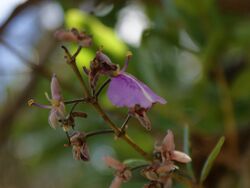Biology:Qualea parviflora
From HandWiki
Short description: Species of tree
| Qualea parviflora | |
|---|---|

| |
| Scientific classification | |
| Kingdom: | Plantae |
| Clade: | Tracheophytes |
| Clade: | Angiosperms |
| Clade: | Eudicots |
| Clade: | Rosids |
| Order: | Myrtales |
| Family: | Vochysiaceae |
| Genus: | Qualea |
| Species: | Q. parviflora
|
| Binomial name | |
| Qualea parviflora | |
Qualea parviflora, known as pau-terra in Portuguese, is a deciduous tree indigenous to Bolivia, Brazil , and Paraguay.[2] The tree favors dry climates like the tropical savanna of the cerrado.[3][4][5]
Description
Qualea parviflora grows up to 8 m (26 ft) tall. It flowers between September and December. Each flower as one light purple petal, a single stamen, a spurred calyx, and a three-parted ovary. Pau-terra can be distinguished from a close relative Qualea multiflora by its smaller flowers.[6]
Ecology
The flowers are pollinated by bees.[6] The seeds are eaten by buprestid beetles and small Hymenoptera species.[6] Caterpillars of the dalcerid moth Dalcera abrasa feed on Quaela parviflora.[7]
References
- ↑ Martius, Karl Friedrich Philipp von (1824). "Qualea parviflora" (in la). Nova genera et species plantarum :quas in itinere per Brasiliam MDCCCXVII-MDCCCXX jussu et auspiciis Maximiliani Josephi I., Bavariae regis augustissimi instituto /. Impensis Auctoris. pp. 135–136. https://biodiversitylibrary.org/page/744646.
- ↑ "Qualea parviflora Mart.". Royal Botanical Gardens Kew. https://powo.science.kew.org/taxon/urn:lsid:ipni.org:names:870961-1.
- ↑ Gonçalves-Alvim, SJ; Collevatti, RG; Fernandes, GW (August 2004). "Effects of genetic variability and habitat of Qualea parviflora (Vochysiaceae) on herbivory by free-feeding and gall-forming insects.". Annals of Botany 94 (2): 259–68. doi:10.1093/aob/mch136. PMID 15234928.
- ↑ Heckman, Charles W. (1998) (in en). The Pantanal of Poconé: Biota and Ecology in the Northern Section of the World’s Largest Pristine Wetland. Springer Science & Business Media. ISBN 9780792348634. https://books.google.com/books?id=PZmasYsyjg4C&pg=PA188.
- ↑ Lorenzi, Harri; Flora, Instituto Plantarum de Estudos da (2002) (in en). Brazilian Trees: 4th ed. Instituto Plantarum de Estudos da Flora. p. 365. ISBN 9788586714177. https://books.google.com/books?id=1ypFAQAAIAAJ.
- ↑ 6.0 6.1 6.2 Custódio, Luciana Nascimento; Carmo-Oliveira, Renata; Mendes-Rodrigues, Clesnan; Oliveira, Paulo Eugênio (September 2014). "Pre-dispersal seed predation and abortion in species of Callisthene and Qualea (Vochysiaceae) in a Neotropical savanna". Acta Botanica Brasilica 28 (3): 309–320. doi:10.1590/0102-33062014abb3064.
- ↑ "HOSTS - The Hostplants and Caterpillars Database at the Natural History Museum". https://www.nhm.ac.uk/our-science/data/hostplants/search/detail.dsml?PK_MainID=8227&PSpeciesqtype=starts+with%3dstarts+with%3dmalvae%3dFamily%3d13%253A1%253A0%3dstarts+with%3dstarts+with%3dpyrgus%3dstarts+with%3dstarts+with%3d%2525&beginIndex=1501&listPageURL=list%2edsml%3fbeginIndex%3d1500%26PSpeciesqtype%3dstarts%2bwith%253dstarts%2bwith%253dmalvae%253dFamily%253d13%25253A1%25253A0%253dstarts%2bwith%253dstarts%2bwith%253dpyrgus%253dstarts%2bwith%253dstarts%2bwith%253d%252525&.
Wikidata ☰ Q15336649 entry
 |


